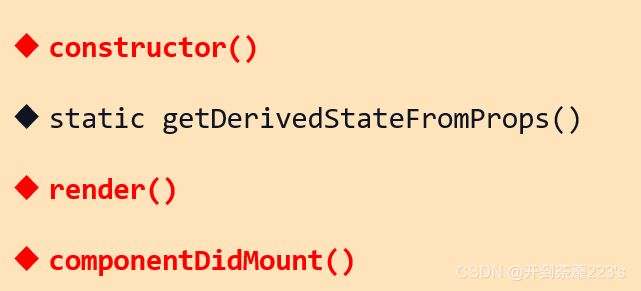React组件三大属性props state refs以及组件的生命周期
props属性
React组件可以通过JavaScript函数方式实现, 那么React组件就可以接受参数的传入。React框架定义了一个Props的概念, 主要用来实现React函数组件接受参数的输入。
props属性:从组件外部向组件内部传递变化了的数据,在组件内部不能改变它的值,props除了可以传字符串、数字,还可以传数组,对象、甚至是回调函数,它的主要作用是从父组件向子组件传递数据,它是不可改变的。
读取props属性值: this.props.属性名
向props中传值: <组件名 属性名='值'/>
设置类组件的默认值:组件名.defaultProps={ 属性名:默认值 }
向props中传值
<div id="example"></div>
<script type="text/babel">
// 定义函数组件
function PropsDemo(props){
if(props){
return (<div>
<p>你好:{props.name}</p>
<p>年龄:{props.age}</p>
</div>)
}
}
// 将函数转化为组件
const element = <PropsDemo name="梓琳" age="23" gender="Girl"/>
// 渲染组件
ReactDOM.render(element,document.getElementById('example'))
</script>
设置类组件的默认值
<div id="example"></div>
<script type="text/babel">
// 创建类组件
class PropsComponent extends React.Component{
render(){
return (<div>
<p>类的默认值:{this.props.default}</p>
<p>类的默认值2:{this.props.address}</p>
</div>)
}
}
// 定义类组件的默认值
PropsComponent.defaultProps = {
default:'西湖',
address:'杭州'
}
const element = <PropsComponent/>
const reactDiv = (
<div>{element}</div>
)
ReactDOM.render(reactDiv,document.getElementById('example'))
</script>
state属性
由于React对props有严格的保护机制,一旦给定值,在组件中是不允许改变的,在很多情况下,组件的内容需要根据数据的刷新而刷新,这个时候就可以用到React提供的State,在这里称之为状态机,State与Props都是React的私有的,但不同的是,State是完全受控于组件的,所定义的属性值可以根据需求而改变,并在虚拟DOM上同步更新。
React框架之所以定义这个状态(State) 概念, 目的就是通过更新React组件的状态(State) , 就可以实现重新渲染用户界面的操作(这样就不需要操作DOM了) ,这点也是React设计理念相较于其他前端框架的先进之处,React State的使用方法相比于Props较为复杂一些, 但也是有基本模式的。
特性: 指组件通过与用户交互,实现不同的状态,然后通过渲染UI保证用户界面和数据一致性
应用场景: 组件的内容需要根据数据的刷新而刷新
创建方法: 在类的构造函数中定义
class isState extends React.Component{
//利用ES6class继承方法可以将props传递到isState构造函数中
constructor(props){
super(props);
// 定义状态机
this.state = {
value:'状态机'
}
}
}
React组件的生命周期(挂载)
生命周期: 组件从创建到加载运行再到卸载的整个过程就是生命周期
注意:只有类组件才有生命周期
每个组件都包含"生命周期方法",可以重写这些方法便于在运行过程中特定的阶段执行这些方法
组件挂载
1.进行组件的构造(初始化): 通过调用constructor函数来实现,为组件定义状态机时必须有构造函数 this.state = {},在给事件绑定函数时必须有构造函数
2.getDerivedStateFromProps(): 获取组件的状态机和props属性值(一般不要重写)
3.进行组件的渲染: render()是class组件(类组件)中必须实现的方法。render()是一个纯函数,需要return返回值,这意味着在不修改组件state的情况下,每次调用时都返回相同的结果,并且它不会直接与浏览器交互。
4.componentDidMount(): 会在组件挂载后(插入 DOM 树中)立即调用
组件更新
当props和state发生改变时,组件就会更新,
1.调用render()方法: 对组件进行重新渲染
2.调用componentDidUpdate()方法: 对挂载的组件进行更新
组件卸载
**调用componentWillUnmount():**会在组件卸载及销毁之前直接调用。在此方法中执行必要的清理操作。例如,清除timer,取消网络请求或清除
挂载(mount):当组件实例被创建并插入 DOM 中时,其生命周期调用顺序如下:

时钟组件的生命周期
<div id="myClock"></div>
<script type="text/babel">
class Clock extends React.Component{
constructor(props){
super(props);
this.state = {// 状态机
show:true,
date:new Date(),
text:'隐藏'
}
// 在自定义函数中this为null 若要在自定义函数中使用this 就必须进行绑定(将this强制绑定到自定义函数中)
this.handelShow = this.handelShow.bind(this)
}
// 挂载函数(钩子函数)
componentDidMount(){// 创建定时器 每隔1秒钟调用一次tick函数
this.timerID = setInterval(()=>{
this.tick(),1000
})
}
// 定义tick函数:更新状态机中的date
tick(){
this.setState({
date:new Date(),
})
}
// 定义事件响应函数 用来更新状态机中的show和text(决定显示在按钮上的文本)
handelShow(){
this.setState({
show:!this.state.show,
text:!this.state.show?'隐藏':'显示'
})
// this.setState((state)=>{ //两种写法
// show:!state.show;
// text:!state.show?'隐藏':'显示'
// })
}
// 组件卸载函数(钩子函数):清除定时器
componentWillUnmount(){
clearInterval(this.timerID)
}
render(){
let isShow = this.state.show;
let element;
if(isShow){
element = <h2>{this.state.date.toLocaleTimeString()}</h2>
}else{
element = null
}
return (
<div>
<button onClick={this.handelShow}>{this.state.text}计时器</button>
<br />
{element}
</div>
)
}
}
ReactDOM.render(<Clock/>,document.getElementById('myClock'))
</script>
- state:状态机,组件自身的可以变化的数据
- props:从组件外部向组件传递的数据,在组建内部对props只能读不能改
refs属性
refs属性主要作用是读取组件内部的标签的值,在组件内部可以给标签定义ref属性,用于标识标签,使用 this.refs.标签的ref的属性值 就可以获取对应的标签
在React中获取虚拟组件中的标签的值
1.使用组件的refs属性
2.在虚拟组件的标签中定义事件 在事件中通过箭头函数来获取标签的值
this.input = info)/}
3.使用事件对象—>event
handleBlur(event){ //'event'代表的是产生事件的对象
alert(event.target.value)
}
<div id="text"></div>
<script type="text/babel">
// 1.定义组件类
class RefComponent extends React.Component{
constructor(props){
super(props);
this.showInput = this.showInput.bind(this);
}
showInput(){
const tempInput = this.refs.content;
alert(tempInput.value);
}
handleBlur(event){
alert(event.target);
}
render(){
return (
<div>
<input type="text" ref='content' />
<button onClick={ this.showInput }>显示</button>
</div>
)
}
}
// 2.渲染组件
ReactDOM.render(<RefComponent/>,document.getElementById('text'))


